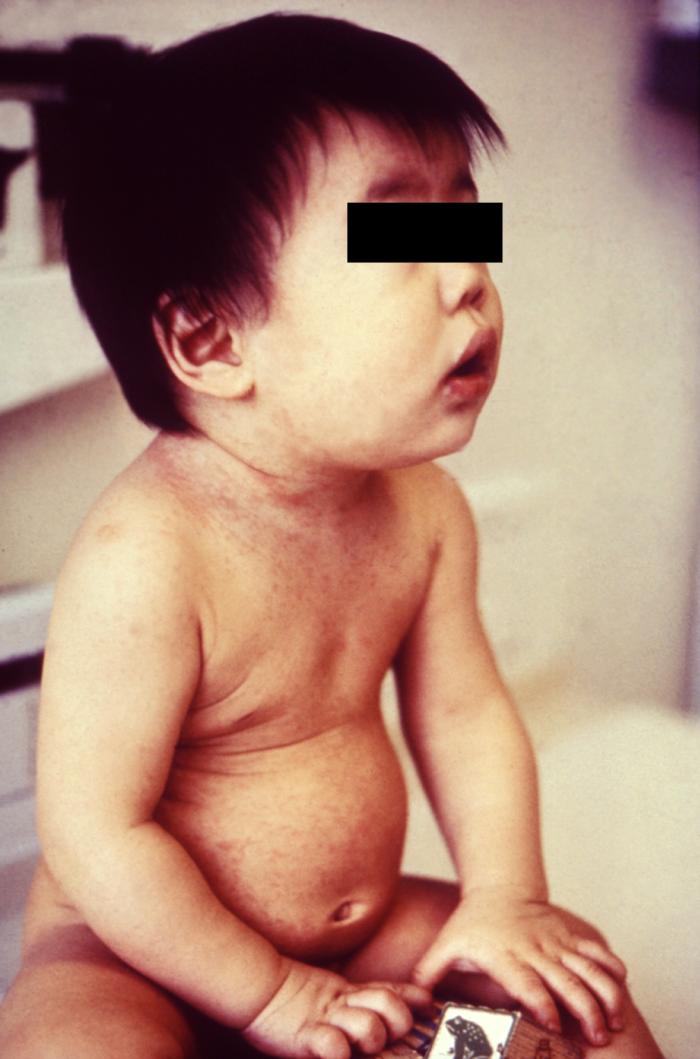Rubella physical examination: Difference between revisions
Ochuko Ajari (talk | contribs) No edit summary |
|||
| Line 1: | Line 1: | ||
__NOTOC__ | |||
{{Rubella}} | {{Rubella}} | ||
{{CMG}} | {{CMG}} | ||
{{MJM}} | {{MJM}} | ||
==Acquired rubella== | ==Acquired rubella== | ||
The incubation period of rubella is 14 days, with a range of 12 to 23 days. [[Symptoms]] are often mild, and up to 50% of [[infections]] may be subclinical or inapparent. In children, [[rash]] is usually the first manifestation and a [[prodrome]] is rare. In older children and adults, there is often a 1 to 5 day prodrome with low-grade [[fever]], [[malaise]], [[lymphadenopathy]], and upper [[respiratory]] symptoms preceding the rash. The rash of rubella is [[maculopapular]] and occurs 14 to 17 days after exposure. The rash usually occurs initially on the face and then progresses from [[head]] to [[foot]]. It lasts about 3 days and is occasionally [[pruritic]]. The rash is fainter than [[measles]] rash and does not coalesce. The rash is often more prominent after a hot shower or bath. Lymphadenopathy may begin a week before the rash and last several weeks. [[Postauricular]], posterior [[cervical]], and [[suboccipital]] nodes are commonly involved. | The incubation period of rubella is 14 days, with a range of 12 to 23 days. [[Symptoms]] are often mild, and up to 50% of [[infections]] may be subclinical or inapparent. In children, [[rash]] is usually the first manifestation and a [[prodrome]] is rare. In older children and adults, there is often a 1 to 5 day prodrome with low-grade [[fever]], [[malaise]], [[lymphadenopathy]], and upper [[respiratory]] symptoms preceding the rash. The rash of rubella is [[maculopapular]] and occurs 14 to 17 days after exposure. The rash usually occurs initially on the face and then progresses from [[head]] to [[foot]]. It lasts about 3 days and is occasionally [[pruritic]]. The rash is fainter than [[measles]] rash and does not coalesce. The rash is often more prominent after a hot shower or bath. Lymphadenopathy may begin a week before the rash and last several weeks. [[Postauricular]], posterior [[cervical]], and [[suboccipital]] nodes are commonly involved. | ||
| Line 23: | Line 21: | ||
==References== | ==References== | ||
{{Reflist|2}} | {{Reflist|2}} | ||
[[Category:Teratogens]] | |||
[[Category:Viral diseases]] | |||
[[Category:Pediatrics]] | |||
[[Category:Togaviruses]] | |||
[[Category:Infectious disease]] | |||
[[Category:Emergency medicine]] | |||
[[Category:Primary care]] | |||
[[Category:Needs overview]] | |||
{{WH}} | |||
{{WS}} | |||
Revision as of 14:54, 26 February 2013
|
Rubella Microchapters |
|
Diagnosis |
|---|
|
Treatment |
|
Case Studies |
|
Rubella physical examination On the Web |
|
American Roentgen Ray Society Images of Rubella physical examination |
|
Risk calculators and risk factors for Rubella physical examination |
Editor-In-Chief: C. Michael Gibson, M.S., M.D. [1] Michael Maddaleni, B.S.
Acquired rubella
The incubation period of rubella is 14 days, with a range of 12 to 23 days. Symptoms are often mild, and up to 50% of infections may be subclinical or inapparent. In children, rash is usually the first manifestation and a prodrome is rare. In older children and adults, there is often a 1 to 5 day prodrome with low-grade fever, malaise, lymphadenopathy, and upper respiratory symptoms preceding the rash. The rash of rubella is maculopapular and occurs 14 to 17 days after exposure. The rash usually occurs initially on the face and then progresses from head to foot. It lasts about 3 days and is occasionally pruritic. The rash is fainter than measles rash and does not coalesce. The rash is often more prominent after a hot shower or bath. Lymphadenopathy may begin a week before the rash and last several weeks. Postauricular, posterior cervical, and suboccipital nodes are commonly involved.
Arthralgia and arthritis occur so frequently in adults that they are considered by many to be an integral part of the illness rather than a complication. Other symptoms of rubella include conjunctivitis, testalgia, or orchitis. Forschheimer spots may be noted on the soft palate but are not diagnostic for rubella.
Images
-
The young boy pictured here, displayed the characteristic maculopapular rash indicative of rubella, otherwise known as German measles, or 3-day measles. Rubella is a respiratory viral infection characterized by mild respiratory symptoms and low-grade fever, followed by a maculopapular rash lasting about 3 days. In children there may be no significant respiratory prodrome and the illness may not be diagnosed since the rash may be mild and mimic other conditions. It is estimated that 20-50% of infections are subclinical. Complications occur more frequently in adult women, who may experience arthritis or arthralgia, often affecting the fingers, wrists and knees. These joint symptoms rarely last for more than a month after appearance of the rash.
-
The young boy pictured here, displayed the characteristic maculopapular rash indicative of rubella, otherwise known as German measles, or 3-day measles. Rubella is a respiratory viral infection characterized by mild respiratory symptoms and low-grade fever, followed by a maculopapular rash lasting about 3 days. In children there may be no significant respiratory prodrome and the illness may not be diagnosed since the rash may be mild and mimic other conditions. It is estimated that 20-50% of infections are subclinical. Complications occur more frequently in adult women, who may experience arthritis or arthralgia, often affecting the fingers, wrists and knees. These joint symptoms rarely last for more than a month after appearance of the rash.
-
This is an 11 mo. old infant with a mild rubella rash, as well as a nondescript secondary macular eruption.
-
Neck of male patient with rubella.
-
This patient presented with a generalized rash on the abdomen caused by German measles (rubella).




